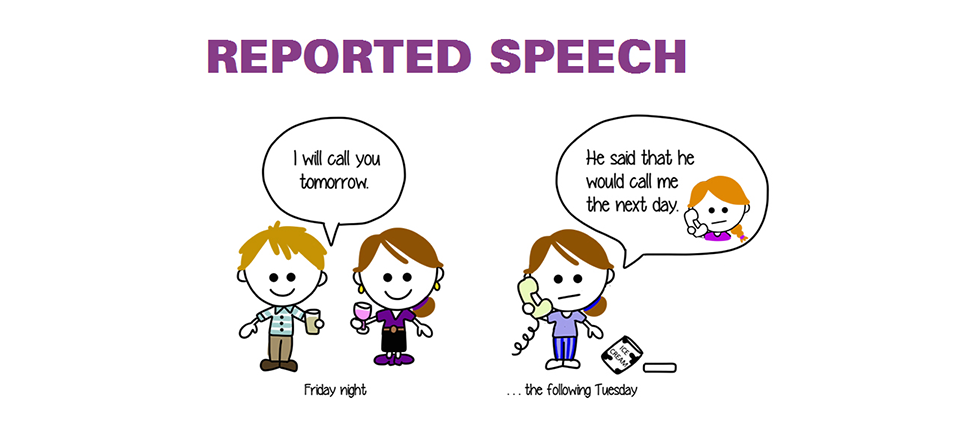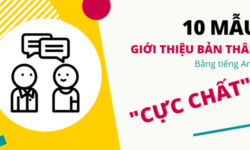Nội dung chính
Hôm nay chúng ta đã gặp một câu chuyện rất thú vị và muốn kể lại điều đó với bạn bè của mình. Lúc này, chúng ta không thể sử dụng những cấu trúc thông thường được nữa mà sẽ cần dùng một loại câu riêng đó là câu tường thuật. Hãy cùng tienganhcaptoc.vn tìm hiểu về các loại câu tường thuật và các dùng của từng loại nhé!
1. Câu tường thuật (Reported Speech) là gì?
Reported Speech hay còn gọi là câu tường thuật, câu gián tiếp, được sử dụng để thuật lại lời nói trực tiếp của một người khác.
Khi chuyển từ một lời nói trực tiếp sang gián tiếp chúng ta cần lưu ý một số vấn đề sau:
1. Nếu động từ tường thuật (reporting verb) chia ở các thì hiện tại chúng ta giữ nguyên thì (tense) của động từ chính, đại từ chỉ định và các trạng từ chỉ nơi chốn cũng như trạng từ chỉ thời gian trong câu trực tiếp khi chuyển sang gián tiếp.
Ví dụ: He says: “I’m going to Ha Noi next week.”
⇒ He says he is going to Ha Noi next week.
2. Nếu động từ tường thuật (reporting verb) của câu ở thì quá khứ thì phải lùi động từ chính về quá khứ một bậc khi chuyển từ lời nói trực tiếp (direct speech) sang lời nói gián tiếp (indirect / reported speech) theo quy tắc sau:
| Lời nói trực tiếp | Lời nói gián tiếp |
| will / shall | would / should |
| am / is / are going to | was / were going to |
| present simple | past simple |
| present continuous | past continuous |
| past continuous | past perfect continuous |
| present perfect | past perfect |
| past simple | past perfect |
| must | had to |
| can | could |
Ví dụ:
Direct speech: “I’ll talk to Mr Jones,” said he.
Reported speech: He said he would talk to Mr Jones.
Một số động từ không thay đổi khi chuyển sang lời nói gián tiếp : would => would, could => could, might => might, should => should, ought to => ought to
Khi chuyển từ lời nói trực tiếp sang gián tiếp mà động từ tường thuật ở thì quá khứ thì các trạng từ chỉ thời gian và nơi chốn và đại từ chỉ định được chuyển đổi theo quy tắc sau:
| Lời nói trực tiếp | Lời nói gián tiếp |
| today | that day |
| tonight | that night |
| tomorrow | the next day / the following day |
| yesterday | the day before / the previous day |
| ago | before |
| now | then |
| next / on Tuesday | the next / following Tuesday |
| last Tuesday | the previous Tuesday / the Tuesday before |
| the day after tomorrow | in two days’ time / two days later |
| this | that |
| these | those |
| this / that | the |
| here | there |
Ví dụ:
Direct speech:
“I’m leaving here tomorrow,” said Mary.
Reported speech:
Mary said (that) she was leaving there the next day.
Nguyên tắc trên được áp dụng cho tất các các loại câu tường thuật.
2. Các loại câu tường thuật cơ bản

2.1. Reported statements
Cấu trúc câu: S + say(s) / said + (that) + S + V
says / say to + O => tells / tell + O
said to + O => told + O
Ví dụ: – He said to me: “I haven’t finished my work.”
He told me he hadn’t finished his work.
2.2. Reported questions
A. Yes / No questions:
Câu tường thuật loại câu hỏi Có hay Không (Yes / No questions) có dạng sau:
| S + | asked (+ O) wanted to know wondered | + if / whether + S + V. |
Ví dụ:
“Are you angry?” he asked.
He asked if / whether I was angry.
“Did you see the film?” Tam asked.
Tam asked if / whether I had seen the film.
Lưu ý: Khi tường thuật câu hỏi Có hay Không (Yes – No questions), ta phải chuyển câu hỏi trực tiếp sang dạng khẳng định, rồi thực hiện thay đổi thì, trạng từ chỉ thời gian, trạng từ chỉ nơi chốn, đại từ chỉ định, và chủ ngữ, tân ngữ, đại từ sở hữu cho phù hợp.
says / say to + O => asks / ask + O
said to + O => asked + O
Ví dụ: He said to me: “Have you been to America?”
He asked me if / whether I had been to America.
B. Wh-questions:
| S + | asked (+ O) wanted to know wondered | + Wh-words + S + V. |
Ví dụ: They asked us: “Where are you going on holiday?”
They asked us where we were going on holiday.
“What are you talking about?” said the teacher.
The teacher asked us what we were talking about.
says / say to + O => asks / ask + O
said to + O => asked + O
Ví dụ: He said to me: “Who are you writing to?”
He asked me who I was writing to.
2.3. Reported commands
Câu tường thuật loại câu mệnh lệnh khẳng định có dạng:
S + told + O + to-infinitive.
Ví dụ: – “Please wait for me here, Mary.” Tom said.
Tom told Mary to wait for him there.
Câu tường thuật loại câu mệnh lệnh phủ định có dạng:
S + told + O + not to-infinitive.
Ví dụ: “Don’t talk in class!” the teacher said.
The teacher told the children not to talk in class.
Một số động từ thường dùng khi tường thuật câu mệnh lệnh: tell, ask, order, advise, warn, beg, command, remind, instruct, ….
3. Bài tập về câu tường thuật trong tiếng Anh
Viết lại những câu sau thành câu tường thuật
1. “Please let me borrow your car.” he said to her.
– He asked… ………………………………………………………………
2. “Jean, have you seen my gloves?” Thomas asked.
– Thomas asked Jean…..
3. Don’t leave the window open, Mary.”, I said.
– I told Mary…. ………………………………………………………….
4. “I’ll have a cup of tea with you.” she said.
– She said that…
5. “I’ll pay him if I can.” she said.
– She said that… ………………………………………………………….
6. “What are you going to do next summer?” she asked.
– She asked us…. ………………………………………………………….
7. “I’ll phone you tomorrow.” he told Jack.
– He told Jack that…. …………………………………………………….
8. “Can I sit beside you, Jean?” Tom asked.
– Tom asked Jean…. ……………………………………………………..
9. “I want a camera for my birthday.” he said.
– He said that…. ………………………………………………………….
10. “Don’t keep the door locked.” he said to us.
– He told us…. ………………………………………………………….
11. “How long are you going to stay?” I asked him.
– I asked him how long….
12. “Are you going by train?” she asked me.
– She wanted to know…. …………………………………………..
13. “Don’t use too much hot water.” she said to us.
– She asked us…. ……………………………………………………..
14. “Will you come to my party?” she said to me.
– She invited me…. ……………………………………………………
15. “Don’t do it again.” she said to them.
She told them…………………………………………………………
16. “ Did Mr Brown send the potatoes to you?” she asked.
– She asked……………………………………………………………..
17. “Don’t get your shoes dirty, boys.” she said.
– She told………………………………………………………………..
18. “What do you want for lunch today, Peter?” Mary asked.
– Mary asked……………………………………………………………..
19. “Can I borrow your typewriter, Janet?” asked Peter.
– Peter asked if ……………………………………………………………..
20. “Why didn’t I get a computer before?” thought the office manager.
– The office manager wondered……………………………………………………
Đáp án
1. He asked her to let him borrow her car.
2. Thomas asked Jean whether/if she had seen his gloves.
3. I told Mary not to leave the window open.
4. She said that she would have a cup of tea with me.
5. She said that she would pay him if she could.
6. She asked us what we were going to do the following summer.
7. He told Jack that he would phone him the following day.
8. Tom asked Jean whether/if he could sit beside her.
9. He said that he wanted a camera for his birthday.
10. He told us not to keep the door locked.
11. I asked him how long he was going to stay.
12. She wanted to know whether I was going by train.
13. She asked us not to use too much hot water.
14. She invited me to come to her party.
15. She told them not to do it again.
16. She asked whether/ if Mr. Brown sent the potatoes to me.
17. She told the boys not to get their shoes dirty.
18. Mary asked what Peter wanted for lunch that day.
19. Peter asked Janet whether/ if he could borrow her typewriter.
20. The office manager wondered why he hadn’t got a computer before.
Câu tường thuật không hề khó phải không? Chúng tôi hy vọng đã cung cấp cho các bạn những kiến thức bổ ích và bài tập thú vị. Hãy nắm chắc kiến thức về câu tường thuật để tự tin làm bài tập cũng như giao tiếp nhé! Chúc các bạn học tốt!







Bình luận